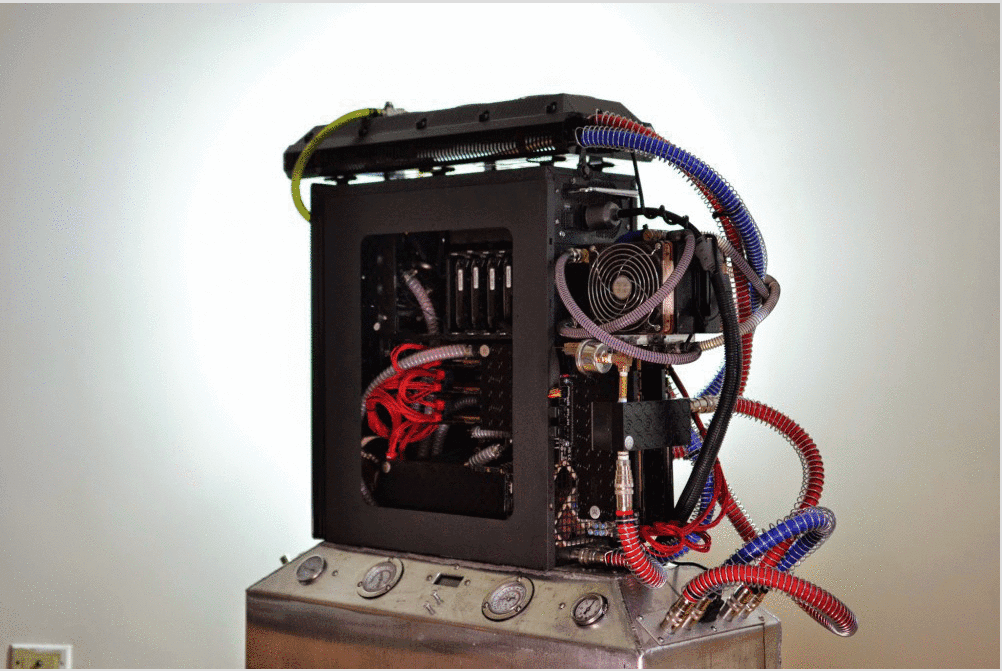Someday we may be heating homes and businesses with computers
Henry, the prototype computer designed by Project Exergy — a computer designed to help you heat your home.
Imagine a future in which electricity generated by solar panels runs powerful computers that can be used to heat our homes.
This is the future envisioned by Lawrence Orsini, founder of Project Exergy. He says his innovation is based on the fact that most of the energy used by computers is turned into heat.
“Computers are really efficient little resistance heaters,” Orsini says. “The amount of energy that gets used in computation is so small it probably can't be measured. So the majority of it — all of it really — is converted directly to heat: Every watt that goes into a computer comes out of it as a watt of heat.”
Orsini says Project Exergy is not interested in just capturing heat from computers: They want to design computers that will generate significantly more heat. “Instead of running them cool and capturing the heat, we look to run them really hot. So we're taking a different twist on this,” Orsini explains.
Orsini has been in the energy industry for about 15 years. He looked at data from the US Energy Information Administration and found that about 40 percent of all the energy consumed in the US is in commercial and residential buildings, and close to half of that energy is used for heat.
He also found that about 2 to 3 percent of energy in the US is consumed by data centers; and 30 -50 percent of that energy goes into cooling the servers. Excess heat is transferred out of the building. Some of the most efficient data centers are actually moving to cooler climates, Orsini says, “so they can just take the roof off and let the heat go directly to the atmosphere.”
“To me, that seems a little backwards,” Orsini says. “If our economy and our buildings and industry actually run on heat, then we ought to be focused on making that heat and not getting rid of it in our data centers.”
Orsini and his collaborators have created a prototype computer, called Henry — a “liquid-cooled, high-performance computer” that makes significantly more heat than a typical computer. Henry is slightly bigger than a normal tower PC and made only from off-the-shelf parts. “There is no Star Trek technology in this thing,” Orsini says. “It's made out of things that you could go buy from the computer store today.”
There is, however, an additional component that works with the computer: a thermal storage tank. This tank is filled with phase change materials that hold significantly more heat than, for example, a typical hot-water heater, Orsini says.
Phase change materials are materials that store and release latent heat. Typically, they store heat by undergoing a solid-liquid phase transformation. Orsini was able to store heated water in Henry’s thermal storage tanks at 200 degrees Fahrenheit.
Orsini lives in an apartment in Manhattan and over the last two winters he hasn't turned the heating units on once, he says. But he sees the possibility of a much broader application. Instead of using centralized data centers, all that heavy computation work would be distributed to computers in buildings and homes, putting the excess heat where it’s needed. “It's pretty hard to ship heat, but it's pretty easy to ship data,” Orsini points out.
“We can put [one of these] in every house in the US. In fact, if we did that and we distributed the two to three percent of energy that is being used in data centers, some of our rough calculations say we can probably heat nearly 80 million houses,” Orsini says.
According to Science Daily, 90 percent of all the data in the world has been generated over the last two years, Orsini says. And the trend is accelerating.
“Think about how that's going to impact the energy consumed in data centers. I personally don't think we're going to be able to sustain that without doing something like this,” he says. "If you look at how energy consumption is climbing through the roof on computation, we have to do something about that. I don't think it’s sustainable, personally.”
A previous version of this story contained several statistical errors. It also inaccurately implied that small personal computers could heat a whole home.
This article is based on an interview that aired on PRI's Living on Earth with Steve Curwood.
